The OnePlus 2 Review
by Brandon Chester on December 14, 2015 8:00 AM EST- Posted in
- Smartphones
- Mobile
- OnePlus
- OnePlus 2
GPU Performance
While general performance on the OnePlus 2 ends up being quite disappointing, when focusing on GPU performance we can hope for a much more appealing outcome as Adreno 430 continues to be one of the best GPUs you can get in a mobile device. While I don't expect there to be a large deviation from the performance of other Snapdragon 810 devices, given the unexpected difference with JavaScript and general CPU performance it's worth running the OnePlus 2 through our standard GPU benchmarks to confirm that everything is performing as expected. As always, we start off with 3DMark, followed by BaseMark X and GFXBench.
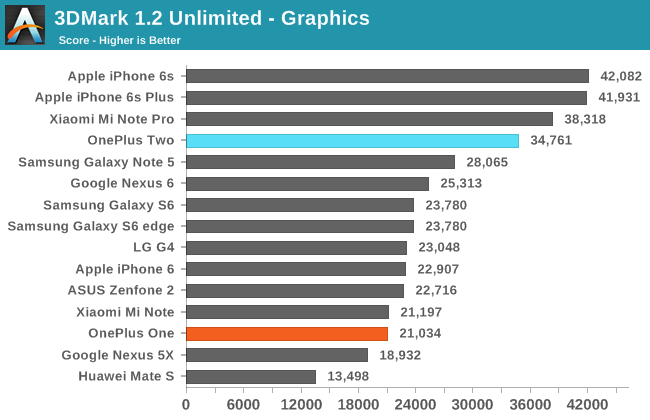

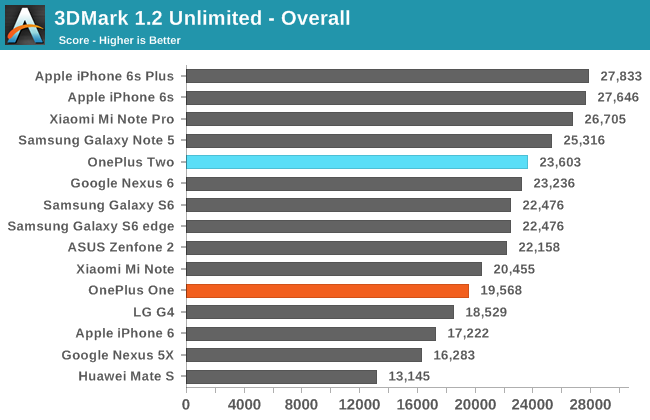
Snapdragon 810's Adreno 430 GPU is still very fast, and it achieves a very high score in 3DMark's graphics test. As usual, the physics test score basically just scales with frequency and number of cores in use, and with the big cores on the SoC throttling down we see a fairly low result there. I don't usually care much for the overall score, but since it's a weighted average we see the OnePlus 2 sitting near the Nexus 6, although in workloads that mainly stress the GPU you'll actually see a much larger gap between the two.
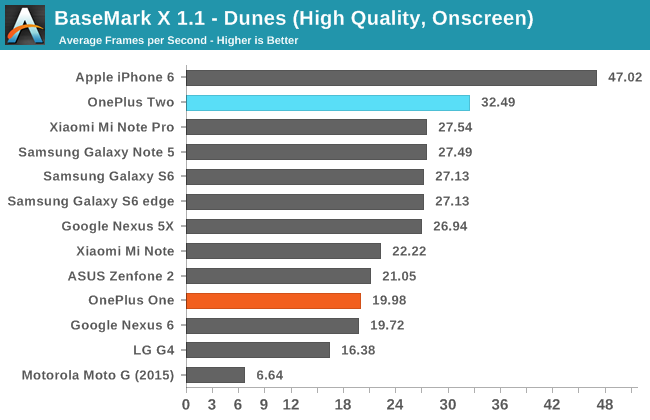
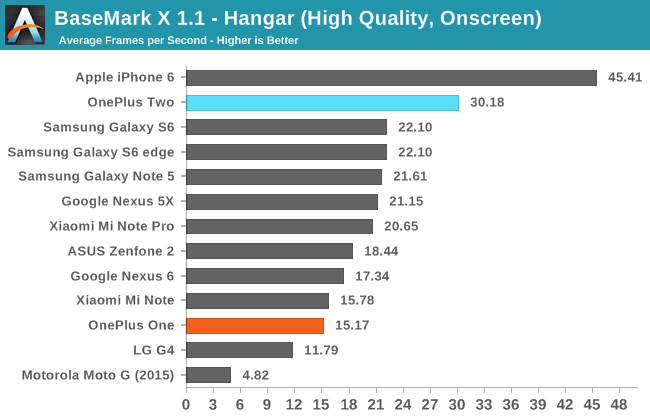
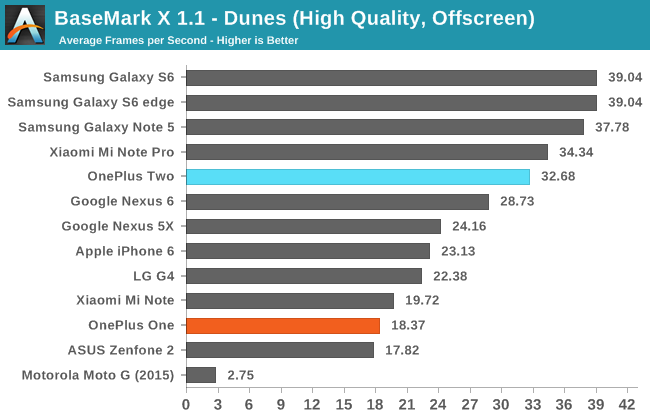
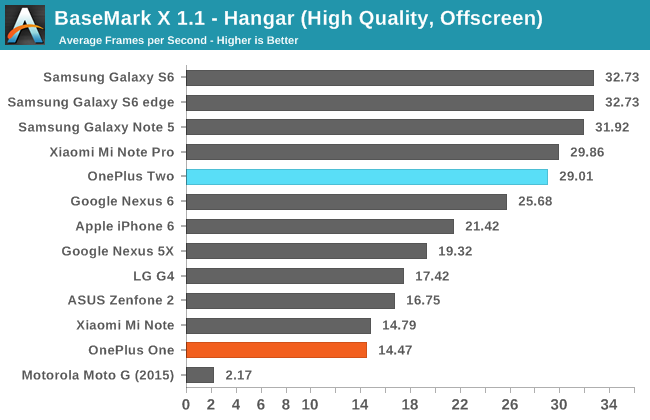
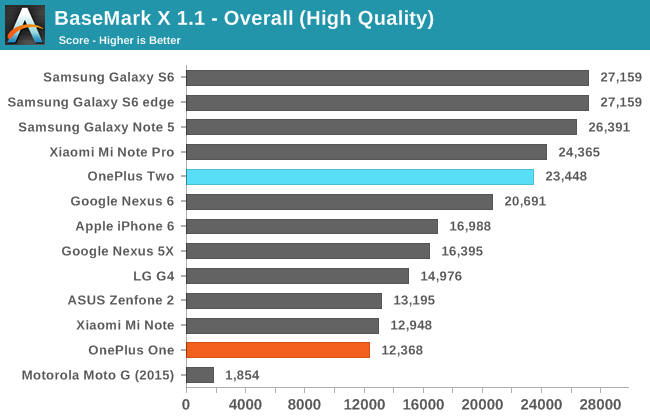
The OnePlus 2 performs very well in BaseMark X, tracking slightly behind the Mi Note Pro which we previously noted may have some level of additional optimizations at the driver level compared to the other Snapdragon 810 implementations. The improvement over the OnePlus One with its Adreno 330 GPU is quite large, with there being nearly a doubling in performance in the Hangar benchmark.

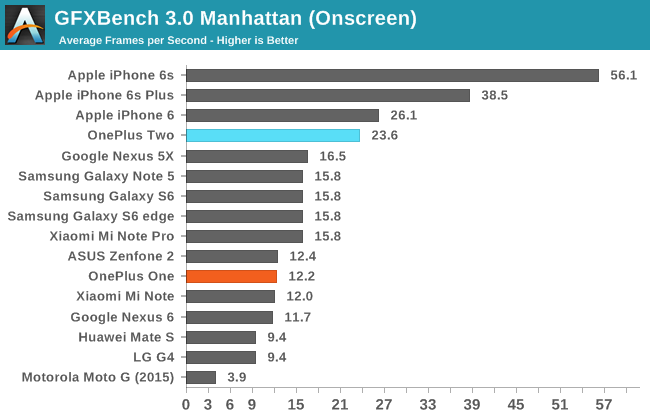

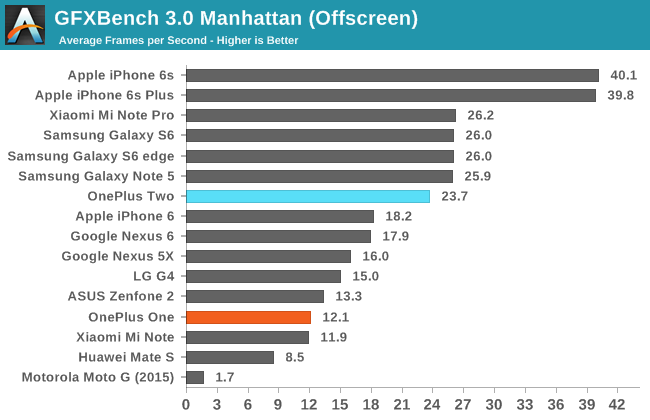
GFXBench's off screen performance results show that the OnePlus 2 is again a bit slower than the Mi Note Pro. In any case the performance is still very good and only really beaten by Samsung's Exynos 7420 devices, and the iPhone 6s. Since the display resolution is only 1080p you actually get better performance in games that run at native resolution than the Mi Note Pro and Galaxy Note5.
Adreno 430 has always been a good GPU, and in general the GPU performance of Snapdragon 808 and 810 hasn't really suffered in the same way the CPU performance has. At $400 the OnePlus 2 definitely gives you a lot of GPU power, and it's something that differentiates it from what's available at lower prices, and even other devices at the same price like the Nexus 5X.
NAND Performance
NAND performance is becoming a greater focus in mobile devices. To improve performance, vendors like Samsung and Apple have turned to solutions outside of the eMMC storage that is typically used in mobile devices. However, the vast majority of products still use eMMC NAND, and in some cases the performance of that NAND can be low enough to introduce noticeable performance issues when using a device. The OnePlus Two uses a Samsung CGND3R eMMC 5.0 NAND solution, which is the same as the one used in the Mi Note Pro.

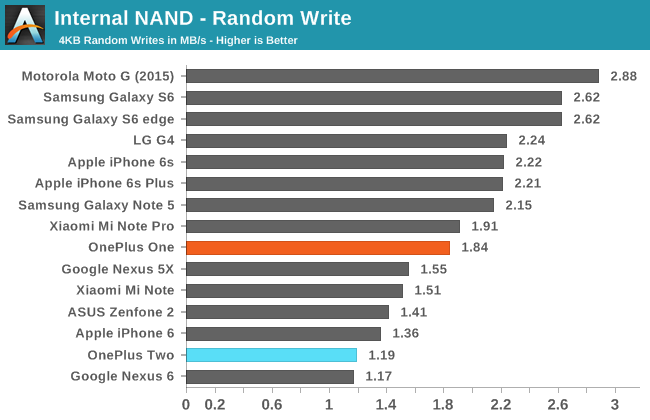
Random read speeds track closely with the Mi Note Pro. Random writes end up being quite a bit slower, and this occurs even with repeated tests so I'm not sure exactly what's causing it.
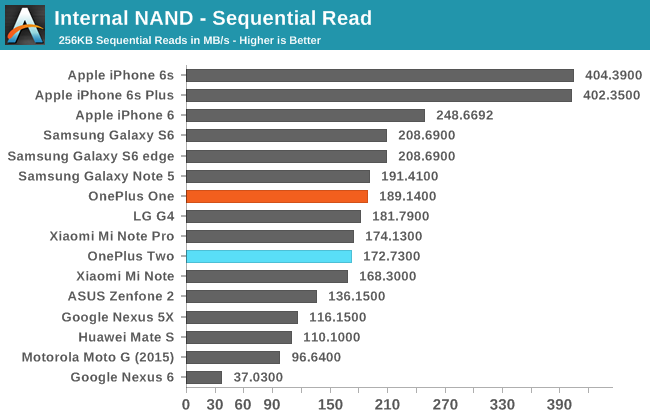
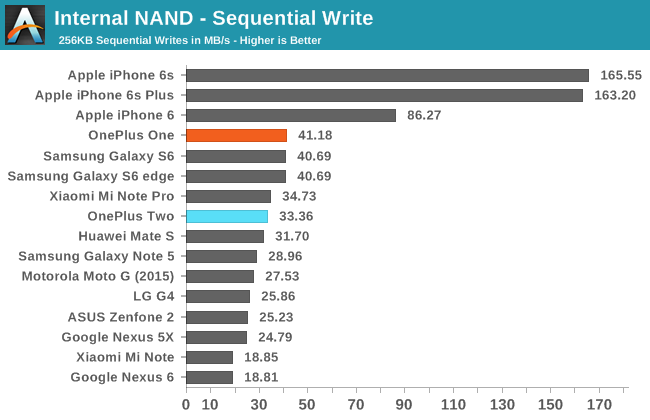
As expected, sequential read and write speeds track almost exactly with the Mi Note Pro. While the results are nothing ground-breaking, they're in line with what you get from an eMMC 5.0 NAND solution. In most cases another component of the phone will likely end up limiting performance before one runs into issues due to NAND speeds, but you won't see some of the benefits that you get with extremely fast NAND such as extremely quick app installation times, faster media transfers, etc.










132 Comments
View All Comments
Huan - Monday, December 14, 2015 - link
Brandon Chester & Ryan Smith, great review as always. Seeing this terrible web browsing java script performance with A57 not activing at all. I am wondering is this review done on the latest OnePlus Two firmware?I currently have OnePlus Two, Galaxy S6 Edge and iPhone 6s Plus, the OnePlus Two is slower then iPhone 6s Plus on web browsing. But it has similar web browsing experience as Galaxy S6 Edge using Chrome.
I am full time engineer, and a part time wedding photographer, I always take picture in RAW and adjust white balance in Lightroom for post processing. When I compared the white point of iPhone 6s Plus ~7000K, to my OnePlus Two, it did look slightly colder, maybe ~7300K but not 8297K. I do noticed OnePlus have sourced panel from different OEMs, maybe I am just lucky and gotten a "more calibrate" display unit in the lottery.
Never the less, OnePlus using a tag line of "2016 Flagship Killer", the least they can do is to ensure consistent calibration on the display and actually build a good kernel that optimize battery life & thermals while taking advantage of SOC's full performance.
Brandon Chester - Monday, December 14, 2015 - link
It is indeed done with the latest firmware. As I mentioned, I also wiped the device to confirm that there wasn't anything weird going on. As an additional confirmation I actually wiped it again around thirty minutes ago, and re-ran the tests. Nothing has improved, and Kraken is actually much worse at 30,000ms because it takes 20,000ms to complete Astar.OnePlus has behavior to automatically detect when Chrome is open and shut off the entire A57 cluster. Even if you use CPUBurn to put extremely heavy loads that activate the A57s they will still shut off the moment you open Chrome. I posted a video of this on Twitter a little while ago to demonstrate it, and you can find it below.
https://twitter.com/nexusCFX/status/67654327791559...
Huan - Monday, December 14, 2015 - link
Brandon, thanks for the reply, I just run Kraken on the OnePlus Two with the latest firmware the best I can do is ~16,000 ms.This is such an unprofessional implementation of the kernel, the easy way out, rather then spending time optimizing performance, battery life and thermals.
grayson_carr - Tuesday, December 15, 2015 - link
The Exynos in the S6 is notoriously poorly optimized for Chrome and has very poor performance in Chrome. The web benchmarks you see on Anandtech for the S6 are using the Samsung browser, which is much better optimized for Exynos. So the OnePlus 2 performing similar to the S6 in Chrome is not a good thing since Qualcomm chips are typically well optimized in Chrome and should perform much better than the Exynos there.zeeBomb - Tuesday, December 15, 2015 - link
I think I read some where you can download chromium that is well optimized for new Qualcomm devices. For Samsung, maybe a binary lib can help but ima agree with you and recommended stock.Lavkesh - Monday, December 14, 2015 - link
What kind of a company parrots "flagship killer" all the time knowing how shitty their product is? Such a huge disappointment.danielfranklin - Tuesday, December 15, 2015 - link
A Chinese company...fguerro - Monday, December 14, 2015 - link
I have a One Plus 2 and out of the box noticed it was slower than expected. However, I installed a custom kernel and set the cpu governor to performance and turned on the A57 from two cores to four and wow, made a big difference in benchmarks and everyday use.3DMark is 1229
Basemark OS II 2.0 Overall is 1927
PCMark Work Performance Overall is 5196
Geekbench 3 Single-Core Score is 1265
Geekbench 3 Multi-Core Score is 5037
AnTuTu v5.7 is 67467
Quadrant Standard is 39128
zeeBomb - Tuesday, December 15, 2015 - link
Damnnn. What custom kernel + ROM are you using? Those are some insane gains.fguerro - Tuesday, December 15, 2015 - link
I'm using stock Oxygen OS 2.1.2 and the custom kernel is Boeffla